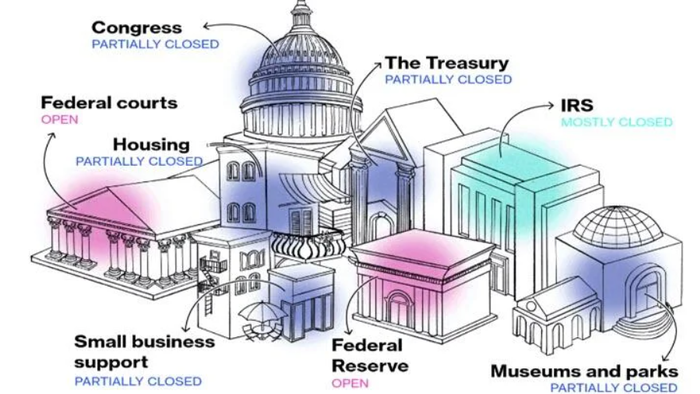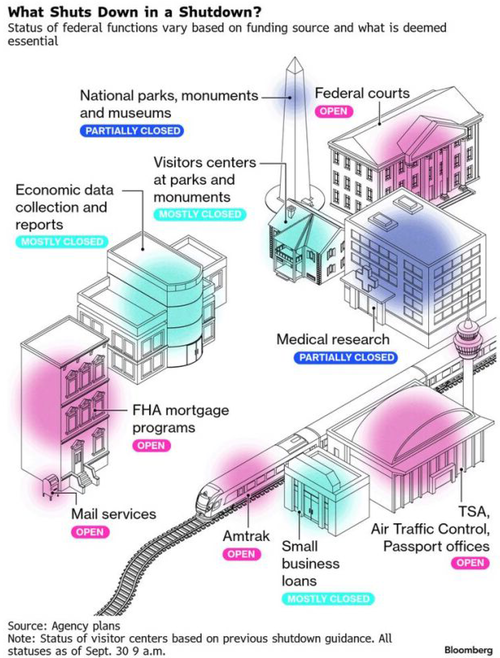


The U.S. government partially shut down at midnight for the first time since 2019 after the Senate rejected a stopgap funding package. In equity markets, U.S. stocks have largely shrugged off the economic and political risks, with JPMorgan noting a high probability that the shutdown could last around 11 to 15 days. The release of the NFP report on Friday and other economic data will likely be delayed.
On the federal jobs front, the Congressional Budget Office estimates that 750,000 employees could be furloughed. Agencies have activated contingency plans that will begin sidelining these workers today, resulting in the suspension of a wide range of services.
Dubbed the "Schumer Shutdown," the effects of a shutdown on the economy will entirely depend on duration. As far as duration, JPMorgan's chair of global research, Amy Ho, told clients there is "a 70% probability of a potential government shutdown lasting around 11-15 days."
Here's a quick snapshot of what's closed, partially closed, and fully open within the federal government.
Bloomberg notes that roughly one-third of federal employees will be furloughed during the shutdown, which is lower than in previous shutdowns, when about 40% of workers were sent home. This brings us to the complete agency-by-agency furlough impact list:
Homeland Security
DHS will furlough nearly 23,000 employees — more than it anticipated last week under a narrowed definition of essential staff. Border, aviation and immigration enforcement will continue, with most Customs and Border Protection, Transportation Security Administration, Immigration and Customs Enforcement and Secret Service staff on duty. Disaster relief and fee-funded immigration services will also continue, while research, training and administrative offices largely shut down.
Defense Department
All active-duty troops keep working, though pay could be delayed. More than 400,000 civilian staff will remain to support combat missions, intelligence, nuclear deterrence and health care. Administrative and training functions will be curtailed, but contracting activities can continue under the Civil War-era Feed and Forage Act. Burials at Arlington National Cemetery go on.
State Department
More than a third of the State Department's 27,000 employees remain on the job. All embassies and consulates will stay open, with passport and visa services funded by fees. Other activities — including new grants, travel, public events and most policy work — would stop. Social media updates will be limited to urgent safety messages.
Transportation
Air traffic control and safety functions will continue and air travel should be unaffected — at least at first. That could change if federal workers start to miss paychecks — previous shutdowns saw higher rates of sick days for air traffic controllers and Transportation Safety Administration agents. Infrastructure grants, research and administrative programs pause.
Social Security
Monthly payments — including retirement, disability and supplemental security income benefits — will continue during a shutdown, funded by permanent appropriations. Applications, appeals, address changes, death reports and direct deposit updates will continue. But non-critical services — including benefit verifications, third-party queries and routine earnings record corrections — will be paused.
Veterans Affairs
About 97% of VA's staff continue working under long-term funding already approved by Congress. Hospitals, suicide prevention programs and the crisis line remain open, as do pension and disability claims. Roughly 15,000 workers in research and administrative roles are slated to be furloughed.
Justice Department
As the nation's chief law enforcement agency, roughly 90% of the Justice Department's 115,000 employees keep working. Criminal prosecutions and investigations continue, but civil litigation will be postponed where possible. The Federal Bureau of Investigation and Bureau of Prisons are largely unaffected, while the Drug Enforcement Administration and Bureau of Alcohol, Tobacco, Firearms and Explosives furloughs more than 2,000 staff.
Internal Revenue Service
The Biden-era Inflation Reduction Act funds the tax collection agency through 2031. Tax collection, enforcement and customer service continue uninterrupted.
Commerce Department
Trump's trade agenda is shielded. Commerce will keep tariff investigations moving under national security exception, a shift from earlier plans that limited work to unexpired funds. Investigations into semiconductors, minerals, aircraft and renewable energy equipment will continue. The Census Bureau will halt all data collection, as will the Bureau of Economic Analysis for reports on gross domestic product, consumer spending, inflation and trade flows. The National Weather Service will continue forecasts and warnings, while most of the National Oceanic and Atmospheric Administration's ships and aircraft return to base and labs shut down.
Labor Department
The Bureau of Labor Statistics will also shut down, delaying the jobs report due Friday and other key indicators. That leaves the Federal Reserve and investors without official benchmarks as they weigh possible rate cuts. Workplace safety inspections continue.
Health and Human Services
HHS will furlough more than 32,000 employees. The Centers for Medicare and Medicaid Services halt casework and the Food and Drug Administration will stop accepting new drug applications. At the Centers for Disease Control and Prevention, only 36% of staff remain, continuing outbreak response and vaccination programs but halting public guidance and surveillance, even during a record measles outbreak.
Education
Already hammered by Trump's attempts to shut down the department completely, Education will furlough 87% of staff, with nearly all remaining employees in the Office of Federal Student Aid. Student loans and disbursements continue, as will collections. But the Office for Civil Rights will halt investigations, and politically sensitive probes of universities and schools would pause.
Agriculture
Most Department of Agriculture staff will be furloughed, though food safety inspections would continue. Food stamps, also called SNAP, and child nutrition programs can keep operating temporarily with carryover funds. Farm loans and rural grants largely stop. The Forest Service maintains firefighting and property protection but shuts down most recreation services.
Interior
The National Park Service will keep sites open to visitors during the shutdown. Their plan calls for tapping into park fees to provide basic visitor services. Read More: National Parks Told to Remain Open During Shutdown Despite Risks
Energy
The Energy Information Administration will suspend data releases. The Nuclear Regulatory Commission halts licensing and inspections, while the National Nuclear Security Administration continues nuclear weapons and reactor operations.
Housing and Urban Development
Most of HUD's work supporting the Federal Housing Administration's portfolio of insured mortgages and Ginnie Mae's work in the secondary mortgage market will go on as normal. Block grants already obligated will keep flowing. But fair housing enforcement stops, and monthly subsidy programs – including those for public housing, housing choice vouchers and multifamily assistance contracts – will operate only as long as funds remain available.
Small Business Administration
Disaster lending and PPP loan forgiveness continues, but most new small-business loans, entrepreneurial training and export programs stop. Oversight of contracting and investment programs will also be suspended.
NASA
NASA is slated to furlough about 80% of its staff, though operations on the International Space Station and Artemis moon missions would continue. Educational outreach and visitor programs will shut down.
Environmental Protection Agency
Nearly 90% of staff will be furloughed. A small number continue work at Superfund sites, building security and emergency response. Permits, grants and enforcement actions will halt.
Financial Regulators The Securities and Exchange Commission keeps fewer than 400 staff, focusing on urgent enforcement while halting most IPO reviews and corporate filing signoffs. The Commodity Futures Trading Commission retains a few dozen employees for basic oversight of derivatives markets, but most other enforcement and regulatory work stops. The Federal Reserve is funded by banking fees, not tax dollars, and is unaffected.
Financial Regulators
The Securities and Exchange Commission keeps fewer than 400 staff, focusing on urgent enforcement while halting most IPO reviews and corporate filing signoffs. The Commodity Futures Trading Commission retains a few dozen employees for basic oversight of derivatives markets, but most other enforcement and regulatory work stops. The Federal Reserve is funded by banking fees, not tax dollars, and is unaffected.
Federal Trade Commission
About one third of the FTC's total staff will stay on during a shutdown, according to the agency's plan. That includes about half of the competition team and 19% of the consumer protection team. The FTC will continue to process submissions from companies seeking approval for mergers.
The White House
Most staff will be furloughed, with only those tied to national security or constitutional duties retained. The National Security Council would keep most of its staff; other policy offices would be sharply reduced. The U.S. Trade Representative keeps about 80 staff to handle WTO disputes and high-priority trade negotiations.
Congress
Members of Congress continue to be paid under the Constitution — and have to be able to work in order to pass a new spending bill to reopen the government. But support agencies such as the Library of Congress and the Botanic Garden close to visitors.
Courts
The judiciary can keep operating at least through Oct. 3 using fee reserves, after which operations may be pared back to constitutional and emergency functions. Each judicial district decides how many employees to keep home, if any. The Supreme Court will open its term Oct. 6 as scheduled.
US Postal Service
Mail delivery and post offices will operate as usual during a shutdown. The Postal Service funds itself through the sale of postage and other services rather than annual appropriations, so its operations aren't affected.
Related:
Schumer Shutdown begins.

